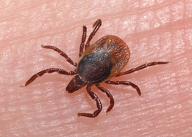Bitten by a tick? The risk that you have been infected with Lyme disease is up to 30%. The CDC recommends 10-21 days of treatment for early infection while the UK recommends a minimum of 21 days for the very same diagnosis. Who is right? What do we really know about Lyme?
NOTE: Take our 10-minute online test to determine your Lyme disease risk level, based on symptoms and their occurrence.
Lyme disease is spreading over the world (Johns Hopkins, 2019). Treatment must be started quickly or it might not work and symptoms may continue to develop (Nice, 2018). The commonly used blood samples can not reliably separate between previous or active infection. False negative tests can occur (Nice, 2018). Diagnosis can be delayed by months or be missed completely.

In northern Europe, up to 30% of ticks have Lyme. The ratio may be lower or higher in other parts of the world. In Europe, it can take up to 72 hours until the Lyme bacteria enters the body. So if you do not discover the tick within this time frame, the risk that you have contracted Lyme disease is around the same as the risk that the tick itself has Lyme.
When the bacteria is inside the human body it is extremely important to quickly get started with treatment. It is mainly by rapid treatment that you can quickly recover fully. If you do not get treatment rapidly the bacteria will hide deeper in the body and may even enter the brain. In these cases, you can no longer count on getting fully restored to your previous health. You may have to suffer “residual symptoms” for years or the rest of life.

Are these “residual symptoms” damages on the body, as most doctors believe or say that they believe, or are Lyme bacteria still swimming around in the body after 10 to 21 days of antibiotic treatment? More and more doctors internationally believes in this later hypothesis and new research proves that they are right. Lyme can survive 28 days of treatment with Doxycycline (Science-daily, 2018).
Only around 50% of Lyme disease patients in northern Europe get a red circle or redness around the bite (Thl.fi, 2016). These patients are usually given treatment quickly, as no blood samples are needed or recommended for diagnosis in this early phase of the disease. However, if you have more diffuse symptoms which are not visible by the eye, there is a large risk that you do not get treatment. It is not even for sure that positive blood samples will help you as most can not distinguish between previous or active infection. One exception to this is if a lumbar puncture test proves that the bacteria has spread to the brain/spinal fluid. However, according to German Lyme disease experts this test has a low chance of finding Lyme disease, especially in early or late situations (Deutsche Borreliose-Gesellschaft, 2010). The headaches may be blamed on stress and why not diagnose the rest as psychosomatic symptoms, i.e. psychologically imagined ones.

In northern Europe, Lyme disease is sometimes treated with just 10 days of Fenoximetylpenicillin, an antibiotic that can not even reach the brain. At the same time, the UK has since April 2018 introduced a new guideline recommending at least 21 days of treatment with the strong antibiotic Doxycycline, even if the only symptom is a red Lyme disease redness around the tick bite. They even recommend double strength treatment if neurological symptoms are present – something which is also indicated by an old Swedish study (L Dotevall, L Hagberg, 1989). France has recently gone even further and allows specialist doctors to treat Lyme disease for as long as needed (HAS, 2018). A new kind of doctors emerge around the world – which goes around the official guidelines and treat their patients until they are well. They often administer carefully selected treatments with multiple simultaneous antibiotics for half a year or longer – and there are many examples where such a treatment has treated even those who had almost no hope left. Some bacteria require long treatments – note that 4 antibiotics for a minimum of 6 months are required for Tuberculosis. A single antibiotic would not do much for Tuberculosis – the bacteria would quickly get resistant to it.
How much do we really know about Lyme disease? Read more about symptoms and do not miss our 10-minute online test to find out how big the risk is that you may have Lyme disease or how active it is. Read more here on DoYouHaveLyme.com by navigating in the menu in the green area above at the top of the page.